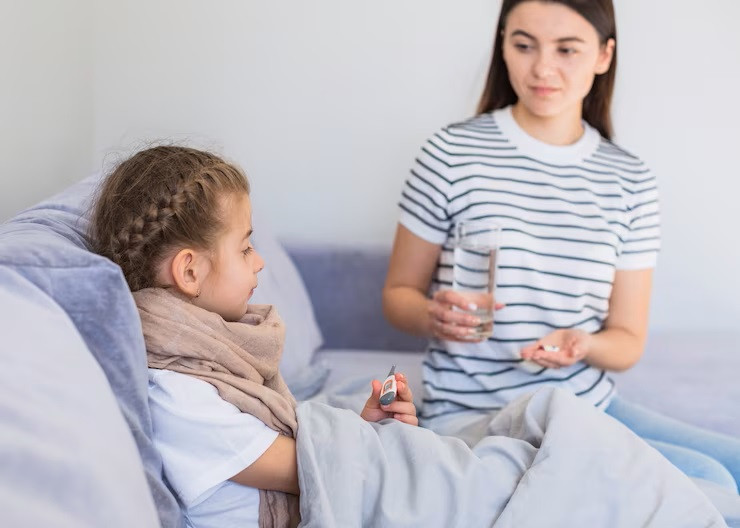The average normal body temperature in children is around 36.4. Children are said to have a fever when their body temperature reaches 37.6 degrees or more. This condition indicates that the body is fighting infection or inflammation.
Generally, fever is not something dangerous. This increase in temperature is a sign that the body is struggling to fight infection or inflammation. However, as a parent, you still need to know what causes fever so that you can help relieve symptoms or prevent worse conditions.
Causes of fever in children after vacation
In general, fever can actually be caused by many things. However, if a child experiences a fever after a holiday, then the infection may attack the child during the holiday.
The following are some common causes of fever experienced by children after vacation:
Dengue fever
Dengue fever spreads easily through the bite of the Aedes aegypti mosquito, which may target children in regions with high dengue fever incidences. Besides the potential for a temperature spike up to 40 degrees Celsius, dengue fever commonly presents with the following symptoms:
- Fatigue, weakness, and lethargy
- Nausea and vomiting
- Abdominal discomfort
- Eye pain
- Joint, bone, and muscle pain
- Intense headache
- Body rash
These symptoms typically manifest 4–14 days post-mosquito bite and persist for 2–7 days. During the early stages of symptoms, it's crucial to meet the child's fluid and nutritional requirements, administer pain and fever management, and monitor for the emergence of additional symptoms.
Malaria
Malaria, too, is caused by mosquito bites carrying the Plasmodium parasite. However, unlike dengue fever, malaria spreads via female Anopheles mosquitoes.
When afflicted with this illness, besides fever, individuals may encounter these accompanying symptoms:
- Chills
- Respiratory symptoms like coughs and colds
- Irritability
- Reduced appetite
- Diarrhea
- Difficulty sleeping
- Nausea
- General body discomfort
- Abdominal pain
- Breathing irregularities
- Jaundice
- Seizures
In some instances, children under five years old might even experience hypothermia or a body temperature drop below normal levels.
Typhoid fever
Typhoid fever is among the illnesses frequently encountered in children following vacations. It's caused by Salmonella typhi bacteria, which can infect children when they consume contaminated food or beverages or come into contact with contaminated surfaces.
The symptoms of typhoid can manifest shortly or a few weeks after exposure. Initially, symptoms include high fever, abdominal pain, and generalized body pain. Without prompt treatment, the abdomen may become distended and swollen.
Hepatitis A
Hepatitis A causes liver swelling and inflammation in children due to infection with the hepatitis A virus. Children typically contract hepatitis A by consuming food or beverages exposed to the virus, neglecting handwashing after using public restrooms, or touching virus-contaminated surfaces.
Initially, the symptoms of this infection resemble those of the flu, making it easy to overlook. However, as the infection progresses, additional symptoms emerge, including:
- Fatigue
- Decreased appetite
- Fever
- Nausea and vomiting
- Abdominal discomfort
- Dark urine
- Light-colored stools
- Jaundice (yellowing of the skin and whites of the eyes)
If your child has a fever after traveling, always monitor the development of symptoms. Have your child checked by a doctor if the fever does not improve or there are other symptoms, as mentioned above. If you need medical advice or consultation, you can either visit a doctor or make use of the consultation features that are available in the Ai Care application by downloading the Ai Care application from the App Store or Play Store.
Looking for more information about other diseases? Click here!
- dr Hanifa Rahma
About Kids Health (2022). Fever in a returning traveller. Available from: https://www.aboutkidshealth.ca/article?contentid=903&language=english
Raising Children (2023). Fever. Available from: https://raisingchildren.net.au/babies/health-daily-care/health-concerns/fever
NHS UK (2020). High temperature (fever) in children. Available from: https://www.nhs.uk/conditions/fever-in-children/
Kids Health (2022). Dengue Fever. Available from: https://kidshealth.org/en/parents/dengue.html
Priya Solomon Bellani (2022). Malaria in babies and toddlers. Available from: https://www.babycenter.in/a1024041/malaria-in-babies-and-toddlers
Kids Health (2023). Typhoid Fever. Available from: https://kidshealth.org/en/parents/typhoid.html
Medline Plus (2022). Hepatitis A: children. Available from: https://medlineplus.gov/ency/article/007670.htm











